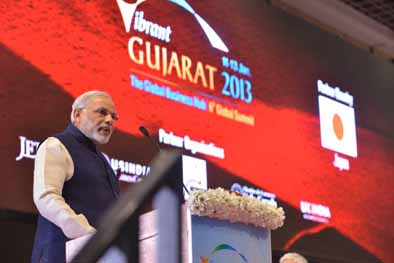Modi&’s PR managers seek to marry his pro-economic development image with the BJP&’s commitment to Hindutva to create a groundswell that might help the party gain majority on its own steam in 2014, writes Rajinder puri
Analysts are scratching heads trying to decipher poll prospects for 2014. One issue of fierce debate is the impact Mr Narendra Modi will have on the results. To assess the rationale behind his projection, the poll strategy of the Rashtriya Swayamsewak Singh (RSS) – which is determinedly naming him as the BJP candidate for Prime Minister – needs to be understood. To decipher it and other related issues, there are two recent newspaper articles that are noteworthy.
First, there was the article by Mr Abheek Barman in The Times of India entitled “Modi&’s Himalayan Miracle”.
The author, quoting facts and figures, has effectively demolished many claims of the Gujarat chief minister. More tellingly, he has rubbished the claimed role of Mr Modi in rescuing 15,000 victims from the Uttarakhand deluge. But the most significant revelation of the article undoubtedly was about the deployment since 2007 of the powerful Israel-dominated public relations agency, Apco Worldwide, to promote the Vibrant Gujarat summits and Mr Modi&’s image. The other day, BJP President Rajnath Singh stated Mr Modi never claimed that he had rescued 15,000 pilgrims from Uttarakhand. Of course, Mr Modi never did that. That was what Apco was being paid $25,000 per month for doing. It would be reasonable to infer that many of Mr Modi&’s assertions and projections are inspired by inputs from Apco. For instance, his recent presentation of two video studies in the Planning Commission meeting may safely be attributed to this source. In that sense, much of the vigorous media and corporate support for Mr Modi may justifiably be credited to Apco.
There is nothing wrong or unique for aspiring political leaders to utilise the services of professional public relations outfits for electoral purpose. But a more significant aspect deserves attention – A highly professional and competent outfit like Apco would not ignore the background and persona of their client in formulating poll strategy. The relations of Mr Modi&’s party with its parent RSS must surely have been taken into account. Therefore would there not have been direct or indirect cooperation between RSS and Apco in forging the poll strategy? If so, to what end?
RSS and BJP leaders backing Mr Modi are openly stating that they aspire for single party majority in 2014 without the help of poll allies. On what premise would this daunting ambition be based? Till now, the BJP campaign is riding on two horses. It is targeting the Hindutva brigade, for which Mr Modi presents a most attractive face. Let it be noted that RSS Chief Mohan Bhagwat has repeatedly asserted the centrality of Hindutva for shaping India&’s future. Most recently, while extolling the legacy of Swami Vivekananda at a function on 19 June, he said, "We have changed leaders and agendas, nothing has worked. Politics is not the way to make India a superpower; it is only Hindutva that can do it." Given such commitment to Hindutva, how would Apco proceed with its campaign?
The answer seems to be simple. Mr Modi&’s claimed commitment to economic development appeals to the rising new generation of young Indians. The commitment to Hindutva appeals to the traditional pro-Hindu vote bank of the BJP. The strategy opted for Mr Modi seems to be to marry both commitments and create a groundswell that might give the BJP single-party majority, which would promise the stability that most Indians desperately yearn for. And how will that marriage be consummated? By convincing India that the Hindu rate of economic growth can be replaced by the new Hindutva rate of economic growth that could make India a superpower. And Mr Narendra Modi, with his background and record as Gujarat chief minister, is the man to accomplish it.
This is a credible strategy and should not be dismissed out of hand. However, there are serious pitfalls to overcome before it can succeed. That brings us to the second recent newspaper article referred to at the beginning of this essay.
In a perceptive analysis, “Doing the Modi Math”, Mr Ashutosh Varshney in The Indian Express has analysed reasons in the past for the accretion of the vote-share by the BJP in elections. Endorsing Mr LK Advani&’s reasoning, he has pointed out that the votes jumped mostly through poll adjustments with allies. However, there were two exceptions to this. Post Emergency in 1977, and post Mr Advani&’s Ayodhya Rath Yatra in 1991, the BJP significantly increased its tally. The Emergency, of course, was a rare issue and Indira Gandhi invited failure without help from opponents. The BJP, the Jan Sangh then, united with other opposition parties to exploit the wave. It is with regard to the 1991 experience that I venture to add a caveat.
In 1991, BJP jumped to 120 seats from 88 during the Mandal agitation and immediately after the Ayodhya movement had consolidated its traditional vote bank. But let it be noted that in 1988, it had jumped from 2 to 88 seats because it had made poll alignment with VP Singh. In 1991, it could successfully bag 120 seats on the basis of its base achieved in 1988. Let it also be noted that it sank to 2 seats in 1984 because the RSS – due to a misplaced sense of patriotism – backed the Congress after the assassination of Indira Gandhi. As a member of the BJP then, I had warned Mr Atal Behari Vajpayee of this switch and predicted that he would lose to Madhav Rao Scindia in the election. This warning was given to him prior to my proposed resignation from primary membership of the party.
To be concluded…
The writer is a veteran journalist and cartoonist. He blogs at www.rajinderpuri.wordpress.com











